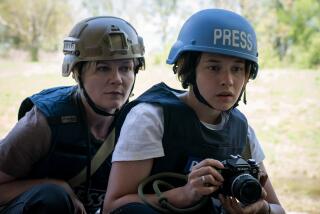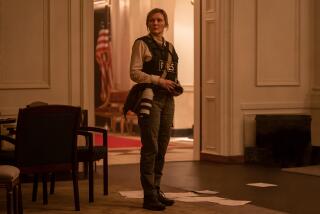Review: Ang Leeâs moving, muddled âBilly Lynnâs Long Halftime Walkâ tells an Iraq War soldierâs story

Justin Chang reviews âBilly Lynnâs Long Halftime Walkâ Directed by Ang Lee, starring Joe Alwyn, Kristen Stewart, Chris Tucker, Garrett Hedlund, Steve Martin, and Vin Diesel. Video by Jason H. Neubert.
âBilly Lynnâs Long Halftime Walk,â Ang Leeâs ambitious, uneven and heroically idiosyncratic new movie, follows a U.S. Army unit on a premature victory tour during the early days of the Iraq War. A few days before their redeployment, the men of Bravo Squad are trotted onto a Texas football field and into the embrace of a gushing, uncomprehending American public â a show of support as surreal and disillusioning as the distant inferno from which these troops have just emerged.
We see a fuzzy glimpse of that inferno early on, when the camera of an embedded reporter catches 19-year-old Spc. Billy Lynn (Joe Alwyn) rushing to the aid of a sergeant under heavy enemy fire. The sergeant succumbs to his wounds, and the media immediately seize on the harrowing footage as a morale-boosting example of American heroism in action.
âBilly Lynnâs Long Halftime Walk,â for its part, pursues a more difficult, nuanced conclusion. Patiently and scrupulously, if not always in the most dramatically sound fashion, it devotes itself to bringing these soldiersâ fraught experience into clearer focus.
I mean that quite literally. Working with the cinematographer John Toll, Lee shot this feature at an unprecedented 120 frames per second (five times the usual rate) and in 4K resolution â an enhancement that, along with the use of 3-D cameras, invests the image with an astonishing crispness. At its intermittent best, the technology â similar to the 48 frames per second that Peter Jackson used for his âHobbitâ trilogy â proves remarkably immersive, capable of investing both a scene of combat and a simple closeup with an almost unnerving physical and psychological intimacy.
The trouble with eliminating one visual barrier, in this case, is that another tends to spring up in its place. And at times in âBilly Lynnâs Long Halftime Walk,â Leeâs pursuit of an intense, uncompromising hyperrealism winds up merely underscoring its own digital artifice.
Should you see the film in one of the few U.S. theaters equipped to project it at the intended 4K, 3-D, 120-fps specifications, you may recognize its glaringly sharp look from the images on your own high-definition TV (especially with the âmotion smoothingâ setting still on). You may also struggle to find your way into a picture whose peripheral elements â the phony, gestural performances of the background extras, the twangy refrain of Jeff and Mychael Dannaâs score â seem much more obtrusive than they do at the standard frame rate.
All this contributes to a fascinating level of aesthetic confusion, one that doesnât feel entirely inappropriate to the moral and psychological disorientation that Lee means to examine. Adapted by Jean-Christophe Castelli from Ben Fountainâs scaldingly humane 2012 novel, âBilly Lynnâs Long Halftime Walkâ casts a hard, mournful gaze at the indignities that its soldiers are made to suffer, from the lingering after-effects of PTSD to the self-serving pageantry that awaits them back home.
From the moment we first meet Billy in a Texas hotel room, his head still throbbing from too many beers and strippers the night before, his unshakable hangover has the feel of a collective metaphor. Under the stern yet protective command of Sgt. David Dime (Garrett Hedlund), Billy and his fellow Bravo soldiers spend the next several hours navigating the bowels of Texas Stadium, where theyâre set to appear during a Dallas Cowboys halftime show.
Before the day is over they will be paraded before a press conference, welcomed by a friendly squad of cheerleaders and held up for the aggrandizement of the Cowboysâ smarmy owner, Norm Oglesby (Steve Martin, an intriguing if distracting presence). Scene-setting references to early-aughties pop culture abound: The men share the stadium stage with a still-intact Destinyâs Child (not playing themselves), and a few actors at the height of their late-â90s stardom â the Hilary Swank of âBoys Donât Cry,â the Mark Wahlberg of âBoogie Nightsâ â are referenced in connection with the movie that a Hollywood producer (Chris Tucker) is trying to make about Bravoâs harrowing recent tour of duty.
Whatever that movie would have ended up looking like, itâs almost certainly a more conventional, less politically charged picture than this one. Even as it evokes the wartime critiques of dramas like âThe Best Years of Our Lives,â âComing Homeâ and âFlags of Our Fathers,â âBilly Lynnâs Long Halftime Walkâ draws its own pointed contrast between some of Americaâs most cherished institutions â football, celebrity, Thanksgiving, Hollywood â and the stark reality of the conflict being waged ostensibly to preserve them.
Every so often Billy flashes back to Iraq, in scenes that plunge us into the everyday tedium and the sudden terror of being on the front lines. We observe his affectionate conversations with Shroom (Vin Diesel), a self-styled Zen philosopher of a sergeant who becomes the storyâs first-scene casualty. And we also see Billyâs subsequent confrontation with an Iraqi insurgent â a scene that, like a similar encounter in Leeâs underappreciated drama âLust, Caution,â refuses to overlook the moral gravity of taking another human life.
A moment like that serves as a jolting reminder of where this filmmakerâs strengths really lie. For all the envelope-pushing digital sorcery in this movie and his previous, Oscar-winning âLife of Pi,â Lee is an old-fashioned classical humanist at heart, one whose greatest achievements, âCrouching Tiger, Hidden Dragonâ and âBrokeback Mountain,â are triumphs of sly social criticism and piercing emotion rather than technical trickery.
Leeâs great recurring theme is the unspoken tension between a societyâs oppressive traditions and a brave individual who refuses to fit the mold. âBilly Lynnâs Long Halftime Walkâ is very much about its heroâs gradual awakening, his realization that he and his comrades have been co-opted by a canned, pseudo-patriotic spectacle. And Alwyn, a gifted British newcomer, captures that epiphany with a quiet sensitivity that is one of the movieâs few unambiguous triumphs.
But the sharp satirical edge that earned Fountainâs novel comparisons to âCatch-22â feels duller and more sluggish on the screen as Lee strains to weave his storyâs dissonant tones and subplots â a behind-the-curtains quickie with a cheerleader, a skirmish with some stadium workers who donât exactly support the troops â into a movie that works as both a compelling psychological portrait and an astute political argument.
There is one sequence that accomplishes both those aims magnificently, using the high-speed, three-dimensional look to forge a powerfully visceral connection between the battleground of the Middle East and the public arena of a sporting event. Watching it, you finally understand why, nearly a decade after a surge of American dramas about the Iraq War (including âThe Hurt Locker,â âIn the Valley of Elahâ and âRedactedâ), Lee opted to return to this not-so-distant past as a means of pioneering a bold new technological future.
Speaking of timing: It would be disingenuous to pretend that âBilly Lynnâs Long Halftime Walkâ doesnât play differently now than it might have just a week earlier. How differently, of course, will vary depending on the viewer; if Americaâs political landscape is a massive Rorschach blot, then the same goes for its political movies.
But through these eyes, Leeâs vision of red-state America in thrall to a vision of its own exceptionalism carries an even harsher sting than he may have intended. By the end of this strained, startling cinematic flashback, itâs possible to leave the theater feeling both a rush of anger and, more surprisingly, a pang of nostalgia.
------------
âBilly Lynnâs Long Halftime Walkâ
MPAA rating: R, for language throughout, some war violence, sexual content and brief drug use
Running time: 1 hour, 50 minutes
Playing: In general release
See the most-read stories in Entertainment this hour Âť
Movie Trailers
More to Read
Only good movies
Get the Indie Focus newsletter, Mark Olsen's weekly guide to the world of cinema.
You may occasionally receive promotional content from the Los Angeles Times.











